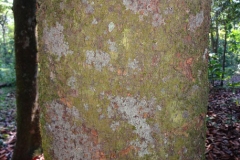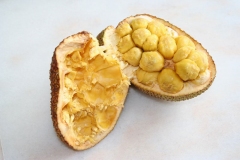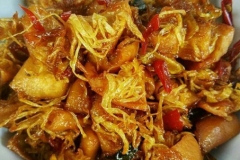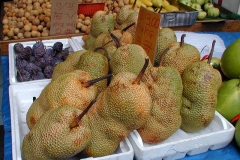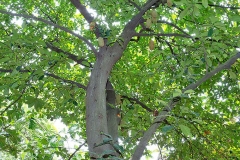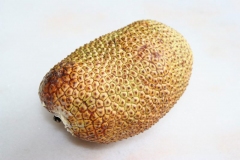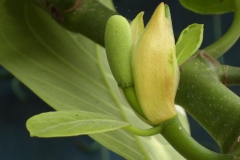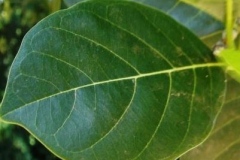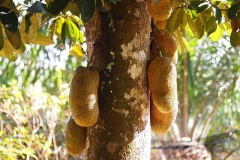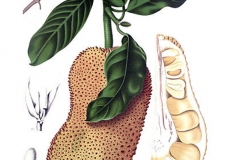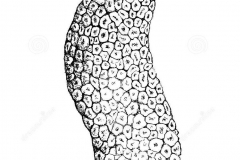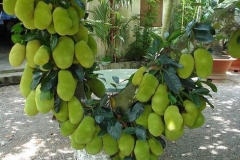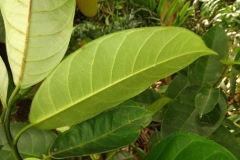Champedan, Chempedak, Small Jackfruit, Bangkong, Banturung manuk, Baroh, Beluno, Bukoh, Campedek, Champada, Chubadak, Kakan, Mangkahai, Nakan, Nangka berit, Nangka tjomedak, Pulutan, Sempedak, Sonekadot, Temedak, Tibadak and Tibudak are some of the popular common names of the plant. The genus name Artocarpus is derived from the Greek words artos, meaning bread and karpos, meaning fruit, referring to the bread-fruit tree. The specific epithet integer is from Latin, meaning undivided, entire, intact or whole. Plant description Cempedak fruit is an evergreen, medium–sized, mid-canopy, branched, monoecious tree that grows about 10–30 m tall. The plant is found growing in secondary forests and locally abundant in primary lowland rainforest, often on wet hillsides. The plant thrives on humus-enriched, loamy, acidic and well-drained soils, but prefers a fairly high water table. However, it does best in deep alluvial soils of open texture. It can also survive periodic water-logging. Stem has white sap; brown stiff, reflexed hairs 3 mm long cover the twigs, stipules and leaves. Trunk Cempedak plant is smaller than the jackfruit plant with an optimal diameter of 15 to 20 cm. Because classified into the family Moraceae, cempedak plant consists of thick sap. The plant has a smooth, grayish-brown surface with bumps on the trunk and main limbs where leafy twigs are produced, which bears the fruits. It is also very suitable to be used as raw materials for making household utensils because it is classified strong and resistant termites. Leaves Its evergreen and alternate leaves are obovate to elliptical in shape, 5-25 cm long and 2.5-12 cm wide. The base is cuneate to rounded, with entire margin, and acuminate apex, glossy green above and pale green and pubescent below. The lateral veins are in 6–10 pairs and curve forward. The medium green leaves held on 1-3 cm long petioles are usually covered with hairs on the midrib and main veins. New shoots, leaf and flower stalk are covered with thin but wiry brown hairs. Flower Flower is monoecious, bearing both male and female flowers on the same tree. The flowers are borne on solitary stalked inflorescence that can be at the leaf axil, on the tree trunk or on the branches. The male flowering head is cylindrical in shape, 3-5.5 cm long and 1 cm wide, and is yellowish-white in color. Most male heads are formed on shoots in the periphery of the canopy that may facilitate pollination by wind. The female flowering head is similar but with distinct filamentous styles on it. The small and greenish female flower heads are found only on cauliflorous shoots. Flowers are cream or off-white and located axillary. Insects visit the scented male inflorescence but not the female ones as they lack nectar. Flowering normally takes place from February to April and then again in August to October. Fruit After the pollination occurs, the female flowers will grow into cempedak fruit which is generally round elongated shape. The average size of cempedak fruit is 20-40 cm long and 10-20 cm in diameter and weighing 1-6 kg. Thorns on the skin of cempedak fruit are not as sharp and as rough as jackfruit. Cempedak fruit is yellowish green when young and becomes brownish-yellow when it is old (ripe). The outer layer of the fruit is green, thick, leathery and patterned with hexagons that are either flat or raised protuberances like the Jackfruit’s skin. The fruit’s taste is comparable to the related Jackfruit (Artocarpus heterophyllus) with a hint of durian. Compared with Jack fruit, Cempedak is sweeter, aromatic, less fibrous and less acidic. Like the Jack fruit, it is a syncarp, composed of fleshy arils or segments, 3-4.5 cm across, colored pale yellow, yellow, orange or green. Each aril surrounds a seed that is edible by boiling or roasting. Seed Cempedak seeds are smaller than jack fruit seeds with shape slightly round, just like the flesh. Just like jack fruit, cempedak seeds can also be consumed after boiling. Seeds are flattened spheres or elongated, about 2-3 cm long. Unlike Jack fruit seeds, they have a thin and edible seed coat. Listed below are some of the well-known health benefits of Cempedak fruit 1. Heart health Antioxidants, dietary fiber and vitamin C present in cempedak help in maintaining heart health. High potassium content helps in lowering blood pressure. It decreases cholesterol levels and reduces hypertension that makes the cardiac system healthier. 2. Healthy eyes Cempedak fruit consists of good amount of Vitamin A which helps to increase health in our eyes. There are many fruits and vegetables that contain Vitamin A but Cempedak fruit becomes one of the sweetest and delicious fruits to be consumed as a supplier of Vitamin A in the body. 3. Maintain digestion Cempedak fruit is also able to help and keep the digestive in our body running smoothly. Vitamin C content in this fruit is able to avoid us from constipation or difficult to defecate. 4. Prevent the risk of stroke Stroke disease becomes a disease that mostly suffered by people who continue to use. But not a few of them are still young age of these disease even children. Cempedak fruit also provides benefits in this regard by preventing the risk of stroke. 5. Lower cholesterol in the blood Cempedak fruit also has benefits for our body in terms of lowering cholesterol levels. Vitamin C content can repel bad cholesterol to prevent blood flow and help good cholesterol to flow smoothly. Bad cholesterol can cause many serious illnesses like heart disease. 6. Relieve tumor There are many health experts who say that Cempedak fruit is able to help treat tumor diseases. But until now there has been no definite thing about it. Seeing from its content such as bioflavonoid most likely can indeed help relieve tumors. 7. Slimming body Consuming Cempedak fruit will give a sense of satiety. This makes Cempedak fruit suitable for their food ingredients or you are committed on slimming. The nutritional content is enough to give a sense of satiety as well as forming the body. 8. Malaria treatment Several compounds like artioindonesianidin and heteriflavon C present in the bark and fruit of cempedak help in prevention and treatment of malaria. It can eliminate the malarial parasites to complete extent. 9. Expel the parasite In the body, we can roam many parasites that can disturb the work of organs. In addition, these parasites can also cause unexpected diseases, Cempedak fruit has benefits to expel parasites – parasites that are not needed by our bodies. Traditional uses and benefits of Cempedak fruit Ayurvedic Health benefits of Cempedak fruit Culinary Uses Recipe Cempedak Butter Cake Ingredients: Directions Cempedak Deep-Fried Fritters Ingredients Direction Goreng Cempedak Ingredients Direction Other Facts Precautions References: https://www.itis.gov/servlet/SingleRpt/SingleRpt?search_topic=TSN&search_value=565608#null https://davesgarden.com/guides/pf/go/176958/ https://pfaf.org/user/Plant.aspx?LatinName=Artocarpus+integer https://plants.usda.gov/core/profile?symbol=ARIN17 https://www.wikidata.org/wiki/Q1053368 http://www.theplantlist.org/tpl1.1/record/kew-2653995 https://en.wikipedia.org/wiki/Artocarpus_integer https://uses.plantnet-project.org/en/Artocarpus_integer_(PROSEA) http://ecocrop.fao.org/ecocrop/srv/en/cropView?id=3435 http://www.asianplant.net/Moraceae/Artocarpus_integer.htm http://tropical.theferns.info/viewtropical.php?id=Artocarpus+integer https://gd.eppo.int/taxon/ABFIN https://infocultures.blogspot.com/2017/05/cempedak-benefits-and-information.html https://www.cabi.org/isc/datasheet/1834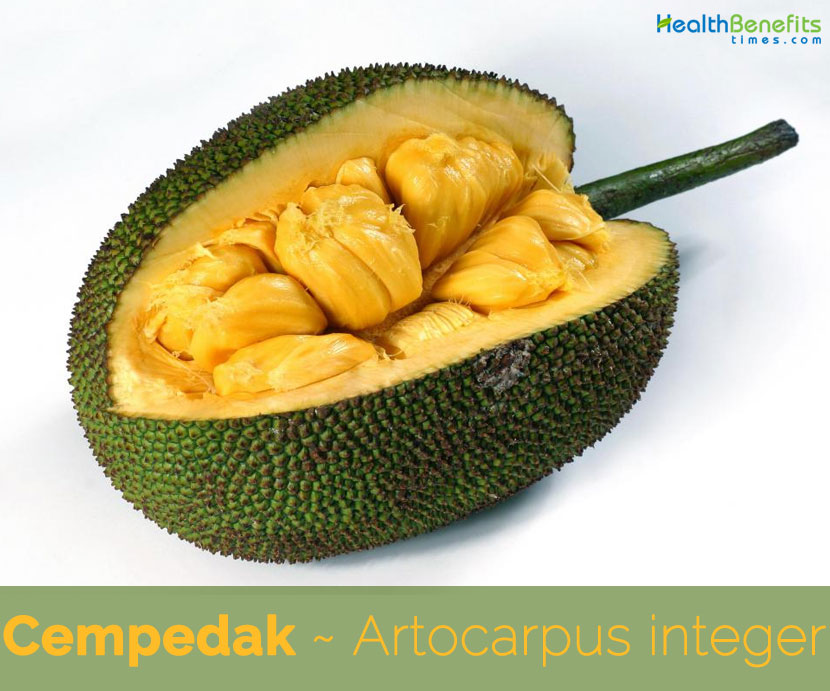
Cempedak fruit Quick Facts
Name:
Cempedak fruit
Scientific Name:
Artocarpus integer
Origin
Thailand, Peninsular Malaysia, Sumatra, Java, Borneo (throughout the island), Sulawesi, Maluku, New Guinea
Colors
Yellowish green when young and becomes brownish-yellow when ripe
Shapes
Round elongated shape, 20-40 cm long and 10-20 cm in diameter and weighing 1-6 kg
Flesh colors
Golden-yellow
Taste
Acrid, sweet, astringent
Artocarpus integer, commonly known as cempedak or chempedak is a species of tree in the family Moraceae, and in the same genus as breadfruit and jack fruit. The plant is native to Southeast Asia. Cempedak is an important crop in Malaysia and is also popularly cultivated in southern Thailand and parts of Indonesia, and has the potential to be utilized in other areas. It is currently limited in range to south-east Asia, with some trees in Australia and Hawaii. In India, it grows in the southern states of Kerala, Andhra Pradesh and Tamil Nadu. Cempedak grows in tropical regions where water is available in abundance. Coastal regions provide the appropriate environment for their cultivation. Cempedak is also called the ugly cousin of the jack fruit.
Health benefits
Heart health, Healthy eyes, Maintain digestion, Prevent the risk of stroke, Lower cholesterol in the blood, Relieve tumor, Slimming body, Malaria treatment, Expel the parasite
Health Benefits of Cempedak
Comments
Awesome


